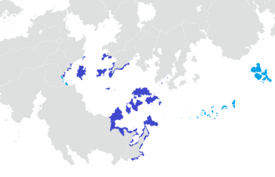Tahamaja Empire
Grand Thalassocracy of Tahamaja Tahamaja, Segara Telas | |||||||||||
|---|---|---|---|---|---|---|---|---|---|---|---|
| 782 CE–1353 CE | |||||||||||
|
Flag | |||||||||||
 The Tahamaja at its height, circa 1150 CE | |||||||||||
| Status | Former Empire | ||||||||||
| Common languages | Uthire | ||||||||||
| Religion | N'nhivara, traditional religions | ||||||||||
| Government | Thalassocracy | ||||||||||
| Pelautama | |||||||||||
• 782-823 CE | Yugah Mardanang | ||||||||||
• 824-865 CE | Garaj Ritarja Anukana | ||||||||||
• | ... | ||||||||||
• 1324-1353 CE | Tuminindyah Selangit | ||||||||||
| Sudasanan | |||||||||||
• 782-823 | Moestadja | ||||||||||
• 825-831 | Adjoikenang Melbama | ||||||||||
• 832-863 | Khoipan Irdokimojim Sukarnoputi | ||||||||||
| Historical era | The Great Expanse | ||||||||||
• Declaration of the 'Padwam Mena' | 782 CE | ||||||||||
• 'Asing Mesa' Declaration | 843 CE | ||||||||||
• Disestablished | 1353 CE | ||||||||||
| |||||||||||
| Today part of | Pulau Keramat, Onekawa-Nukanoa, Ayvana, Fahran | ||||||||||
The Tahamaja Empire, also known as The Grand Tahamaja, was a maritime empire that originated in archipelagic Malaio during the late 8th century with the formal Padwam Mena declaration by the first Pelautama(trans.First Captain) of the Tahamaja, Yugah Mardanang- who had unified the Solustheri Islands under a swift maritime campaign against the various, house based city-states that had formed. The Tahamaja existed as an extremely powerful naval and maritime influence throughout the Ozeros and Karaihe seas, with an exceptionally advanced standard of fleet standards and technological advancements to ensure maritime supremacy. Their control of trade through the Pulaui Archipelago gave access to most of South Ochran, West Scipia, and Malaio in a dominant set of trade settlement establishment and the bolstering of harbor-centered outposts. Being recognized as one of the largest diffusors of technology and exchange of cultural ideas and religions, such as the expansion of N'nhivara throughout it's borders, the Tahamaja eventually collapsed due to a set of internal conflicts exacerbated by disease and plague that was asserted to have been brought and contracted by traders within Norumbia, leading to the inevitable disarray of the Age of Fire.
History
Unification of the Solustheri, and the Padwam Mena
Conquest of the Ayuhaya, and unification of the Archipelago
Asing Mena Declaration, and expansion to Malaio
Golden Age of Ozeros
Decline, and Age of Fire
Geography
Politics & Structure
Military
Kaiponu Tauā
Kaiponu Tauā, often shortened to Kaiponu, were Māori mercenary bands employed by the Tahamaja Empire between the 11th and 14th centuries. Whilst records of individuals and small groups are recorded in service with the Tahamaja Empire as early as the mid 10th century, Kaiponu Taua rapidly grew in prominence at the beginning of the 11th century. Kaiponu Tauā would go on to form a significant portion of fighting strength of the Tahamaja Empire on land, and played key roles in their conflicts with the Shambhalan Empire and Bayarid Empire, as well as Bayarid successor states in southern and south-western Ochran.
Kaiponu Tauā was intially viewed poorly by traditional Māori leaders and was first used as an derogatory term, but by the 12th century the cultural perception had changed significantly as it became a popular option as an anvenue to accrue wealth and mana for those who took part to bring back to their iwi. These resources and experience were of significant advantage to the iwi they returned too and helped to fuel economic, technological and culutural development.
Kaiponu Tauā had no established organisation, differing between groups and their respective iwi's practices on how war was conducted, but leadership was almost always focused on the Kaiponu Rangatira or Chief. Not necessarily a reflection of their status at home, they were almost always at least a close relative to a regular Rangatira if not one themselves, or someone who was considered a Tohunga. Subordinates “officers” selected by the Rangatira were known as Tohunga Tauā and were responsible for anywhere between 40-120 warriors. Particularly large Kaiponu Taua would have a Kaiponu Ariki with their own subordinate Kaiponu Rangatira to help manage the mercenary band. Between the Tohunga Tauā and the common warrior was the Tahu Toa, or first warrior. They lead a small group of warriors rarely larger then 15 and were chosen by common consensus by other warriors.
Kaiponu Tauā had four distinctive components in how they fought and was characterised by its aggressiveness. There was intially only two in the earliest periods of the Tahamaja Empire. Kōtuku Toa were lightly armed skirmishers equipped with a mix of light and heavy throwing spears and small wooden or flax shields, they would engage enemy skirmishers and harrass the primary enemy formation until as late as possible before rapidly discharging their heavy throwing spears. Then the Tūātea Toa, armed with spear and shield would charge into the enemy line with the goal of breaking it and causing a mass rout.
Eventually Jaran Toa would play a key role as the third component and while initially relatively light equipped by the end of the 14th century had become increasingly heavily armed and armoured. Mounted on either horses on Bunyips, these would engage the enemy flanks before attempting an encirclement. The final piece was the heavily armed and armoured Kasan Toa, equipped with heavy two-handed polearns these would frequently be held in reverse to explot any enemy weakpoints.
